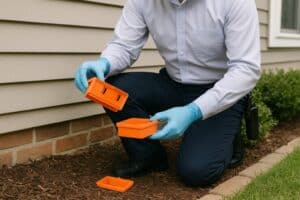Key Takeaways
- Understanding common household pests and their habits helps prevent infestations.
- Proactive measures and regular inspections are crucial for effective long-term pest management.
- Safe and effective pest control methods protect both your home and the environment.
- Seeking help from professionals is sometimes necessary for persistent or severe pest problems.
Understanding Why Pests Invade Homes
No household is entirely pest-proof. Even spotless homes can unexpectedly attract unwelcome critters, leaving residents wondering why pests appear in the first place. At their core, insects and rodents are driven by the need for food, water, and a secure place to hide. Everyday habits, such as leaving pet food out overnight, letting crumbs accumulate under kitchen appliances, or allowing dampness to persist in poorly ventilated areas, can unknowingly invite infestations.

Beyond the noticeable cracks in foundations or visible gaps under doors, pests can access homes through utility penetrations, worn weather stripping, and vents without proper screening. Regularly inspecting these vulnerable spots makes it much more challenging for pests to gain a foothold. In fact, effective Ocala pest control strategies emphasize this proactive identification of problem areas early on. By understanding both the subtle and obvious ways pests infiltrate, residents put themselves in a strong position to prevent infestations before they have a chance to develop. Making these inspections part of a routine is a small but impactful habit that pays off throughout the year.
Common Pests Found in Homes
The culprits behind the most common household pest issues are surprisingly consistent across different climates and regions. Ants can appear in droves, particularly drawn to sugary spills and leftover food. Kitchens and pantries are their favorite haunts, while cockroaches gravitate toward humid bathrooms and laundry rooms where water sources are almost always present. Rodents, such as mice and rats, pose a unique risk: not only do they contaminate food sources and spread diseases, but their constant gnawing can also damage insulation, electrical cords, and even the structure of a home. Spiders, though mostly harmless, seek out dark, quiet corners. While their presence can cause discomfort, a sudden increase in their numbers may signal larger insect populations elsewhere in the home.
In some regions, particularly those with warm and humid climates, mosquitoes pose an ongoing nuisance, both due to their bites and their ability to transmit diseases. Termites represent another serious concern, capable of causing immense structural damage before they are even detected. Knowing the telltale signs of pest activity—tiny droppings beneath sinks, gnawed pantry goods, webbing in corners, wings near window sills—helps homeowners intervene before a minor occurrence becomes an entrenched infestation. It’s worth noting that acting quickly when you see these signs can save substantial time and money, while also minimizing the risk to your family’s health.
Seasonal Shifts: How Pest Pressure Changes with the Weather
Pest pressure is not constant throughout the year. Different species invade homes at different times, responding to environmental changes such as temperature fluctuations and seasonal rainfall patterns. During the warmer spring and summer months, insects such as ants, flies, and mosquitoes become much more active, seeking food and water sources as they reproduce in greater numbers. Conversely, as autumn sets in and temperatures drop, rodents become the predominant threat, searching for warmth and nesting sites inside garages, attics, and basements. These patterns are not just anecdotal—numerous pest management professionals and health organizations track seasonal pest trends, making them a reliable guide for strategic prevention.
Actions such as cleaning gutters in the fall to prevent water pooling and installing weather stripping before winter are proven steps in adjusting pest management approaches. A little seasonal preparedness can have outsized results, making these timely efforts an essential part of any comprehensive strategy.
Preventive Steps Every Homeowner Can Take
- Carefully inspect and seal any cracks, gaps, or holes around foundations, doors, and windows with caulk or weather-resistant sealant. Check periodically for new vulnerabilities.
- Promptly fix leaking pipes, replace dripping faucets, and eliminate unnecessary standing water in crawl spaces or around foundations to cut off a vital source of pest attraction.
- Store pantry items such as flour, grains, and pet food in airtight containers rather than open packages. Regularly clean kitchen counters and vacuum crumbs to minimize attraction.
- Trim bushes, shrubs, and trees to prevent branches from touching or hanging over the roof, which creates easy highways for ants, squirrels, and other climbers. Stack firewood at least 20 feet from your home and elevate it off the ground.
- Dispose of trash frequently and use bins with secure lids. Clean the bins with soap and water to remove residue and odors that attract wildlife and insects.
Tending to these details may seem tedious, but they make a dramatic difference. Preventive habits—when practiced consistently by every member of the household—help establish an environment where pests struggle to survive or reproduce.
Natural and Safe Pest Control Options
Some families prefer to reduce chemical use around the home, especially when young children or pets are present. Diatomaceous earth, a naturally occurring soft rock that crumbles into fine powder, is a highly effective remedy for crawling insects. It works by dehydrating bugs upon contact, yet is generally non-toxic to humans and pets when used correctly. Essential oils, most notably peppermint, tea tree, and citronella, serve as natural deterrents when applied to cotton balls or diluted into spray bottles, effectively repelling many species that might otherwise settle indoors. According to This Old House’s pest control guide, these and other natural methods can be both safe and effective when integrated into a broader prevention strategy.
Other practical measures can also make a significant difference. Vacuum frequently to disrupt pests’ food supply and nesting sites, run a dehumidifier in areas prone to dampness (like basements), and fit mesh screens over windows and vents to keep flying or crawling insects out. Even with natural products, it’s vital to research and test in small areas, ensuring they are both practical and safe. Moderation and attention to usage details can make these methods helpful additions with little risk.
When to Call in a Professional
While prevention and natural remedies help manage small-scale problems, severe or recurring infestations call for professional intervention. Termites, for example, can silently destroy support structures, and once established, they are nearly impossible to eradicate without expert techniques. Similarly, a persistent rodent issue could indicate a hidden nest or entry point that isn’t easily detectable without the use of thorough inspection tools. Specialists possess industry-specific knowledge, training, and equipment—such as thermal imaging and baiting systems—enabling them to diagnose the pest’s source and scope accurately.
Reputable professionals not only remove existing pests but can also suggest ongoing prevention plans and monitor for future outbreaks. These long-term support options provide homeowners with confidence that the solutions are both practical and safe for families, pets, and the environment. When in doubt, reaching out sooner rather than later can mitigate costly repairs or health risks.
Staying Informed: The Importance of Ongoing Education
Pest control is not static. Shifts in weather patterns, the introduction of new invasive species, and regulatory changes routinely shape how pest pressures manifest from year to year. This ongoing evolution highlights the importance of educating oneself about both old and emerging threats. Trusted resources, such as the CDC’s pest management guidance, share expertly curated, research-backed advice for homeowners, covering everything from seasonal tips to safe chemical usage.
Staying engaged with updates through consumer alerts, local pest control organizations, and public health departments means you are prepared for whatever arises. Even established prevention strategies benefit from tweaks and improvements, ensuring your approach is always fresh and aligned with the latest findings. Regularly reviewing new information supports better decisions and proactive responses, fostering a pest-free home for years to come.
Final Thoughts
Achieving a pest-free home is a continuous journey made easier by commitment and common-sense strategies. A blend of vigilance, seasonal adaptation, and a willingness to seek expert help when required helps keep both minor nuisances and major infestations at bay. Ultimately, a small investment in time and attention reaps real rewards in comfort, safety, and peace of mind, making more innovative pest prevention an essential part of modern home care.








